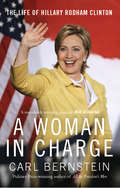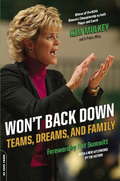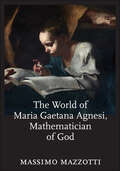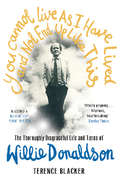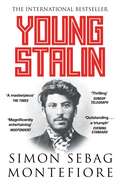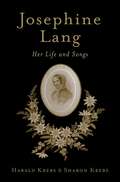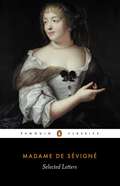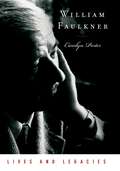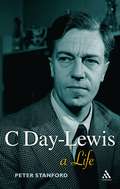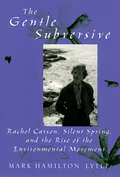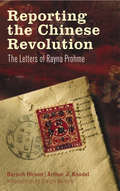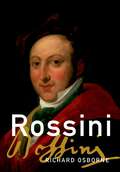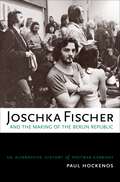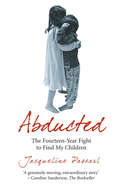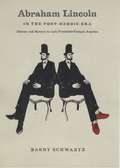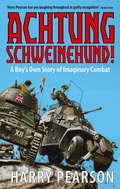- Table View
- List View
A Woman In Charge: The Life of Hillary Rodham Clinton (Thorndike Basic Ser.)
by Carl BernsteinA Woman in Charge reveals the true trajectory of Hillary's astonishing life and career. From a staunchly Republican household and apparently idyllic Midwestern girlhood - her disciplinarian father here revealed as harsher than she has acknowledged - we see the shaping of a brilliant girl whose curiosity was fuelled by the ferment of the 1960s and a desire to change the world. During her student years, she was already perceived as a spokeswoman for her generation. Then, at Yale Law School, she met and fell in love with Bill Clinton, cancelling her own dreams to tie her fortunes to his.Bernstein clarifies the often amazing dynamic of their marriage, charting both her political acumen and her blind spots, and untangling her relationship to the great controversies of Whitewater, Troopergate and Travelgate. And then, in the emotional and political chaos of the Lewinsky affair we see Hillary standing by her husband - evoking a rising wave of sympathy from a public previously cool to her and in effect, Bernstein argues, saving his presidency. It helps carry her into the Senate: her time has come. As she decides to run for President, this self-described 'mind-conservative and heart liberal' has one more chance to fulfill her long-deferred ambitions.Bernstein has interviewed some 200 of her colleagues, friends and enemies and was given unique access to the candid record of the 1992 presidential campaign kept by Hillary's best friend, Diane Blair. Marshalling all the skills and energy that propelled his history-making Pulitzer prize-winning coverage of Watergate, he gives us a detailed, sophisticated, comprehensive and revealing account of the complex human being and political meteor who has already helped define one presidency and may well become the woman in charge of another.
Won't Back Down: Teams, Dreams, and Family
by Kim MulkeyWhether on a baseball field as the only girl on an all-boys team in Hammond, Louisiana, or on a basketball court where her play-making ability was compared to Louisiana legend Pistol Pete Maravich, Kim Mulkey was a young athlete so gifted she was named to Parade magazine's 1980 All-America High School Girls Basketball team.Mulkey went on to win two national championships at Louisiana Tech, as well as a gold medal with the 1984 U.S. Women's Olympic basketball team. She served as an assistant coach on Louisiana Tech's 1988 national championship, then turned around Baylor University's women's basketball program by coaching them to a national championship in a mere five years.In Won't Back Down, Mulkey reveals the many trials she has overcome, and how her children and her coaching have sustained her in her most difficult moments.
Working Stiff: The Misadventures of an Accidental Sexpert (P. S. Series)
by Grant StoddardGrant Stoddard left Britain for the States with the clothes on his back, a fascination with all things American, and a burning hope for something bigger. But with no steady job, no money, and no girlfriend, the starry-eyed young Englishman's excitement was shrinking fast.Then fate in the guise of an X-rated online contest intervened. Winning first prize -- sexual intercourse with an infamous married sex columnist -- changed everything. With a shot of much needed confidence, the sensitive lad emerged as the mascot of Nerve.com, a gonzo sex columnist who would begrudgingly try any and every lurid thing his co-workers devised. From offering himself up as man-bait at a notoriously hard-core gay bar to attending an elite orgy with a blue-blooded date, Stoddard went where few men dare and lived to tell the tale.With a self-deprecating style and wonderful appreciation of the absurd, Working Stiff is a unique coming-of-age story from a very funny and irreverent new writer.
The World of Maria Gaetana Agnesi, Mathematician of God (Johns Hopkins Studies in the History of Mathematics #2)
by Massimo MazzottiShe is best known for her curve, the witch of Agnesi, which appears in almost all high school and undergraduate math books. She was a child prodigy who frequented the salon circuit, discussing mathematics, philosophy, history, and music in multiple languages. She wrote one of the first vernacular textbooks on calculus and was appointed chair of mathematics at the university in Bologna. In later years, however, she became a prominent figure within the Catholic Enlightenment, gave up academics, and devoted herself to the poor, the sick, the hungry, and the homeless. Indeed, the life of Maria Agnesi reveals a complex and enigmatic figure—one of the most fascinating characters in the history of mathematics. Using newly discovered archival documents, Massimo Mazzotti reconstructs the wide spectrum of Agnesi's social experience and examines her relationships to various traditions—religious, political, social, and mathematical. This meticulous study shows how she and her fellow Enlightenment Catholics modified tradition in an effort to reconcile aspects of modern philosophy and science with traditional morality and theology.Mazzotti's original and provocative investigation is also the first targeted study of the Catholic Enlightenment and its influence on modern science. He argues that Agnesi's life is the perfect lens through which we can gain a greater understanding of mid-eighteenth-century cultural trends in continental Europe.
You Cannot Live As I Have Lived and Not End Up Like This: The thoroughly disgraceful life and times of Willie Donaldson
by Terence BlackerThough born into privilege and inheriting a fortune, Willie Donaldson ended up dying alone in a seedy rented flat, his computer still logged on to a lesbian porn site. To some, he had been one of the great, under-rated comic writers of our time, and to others, a dangerous force of corruption and decadence.His achievements were significant - he published Sylvia Plath while still at Cambridge, as a producer in the Sixties he staged Beyond the Fringe, and he was later to write the celebrated Henry Root Letters - but not as impressive as his reckless talent for self-destruction. The impresario became a serial bankrupt. The man about town, who had lived with Sarah Miles and been engaged to Carly Simon, ended up as a ponce in a Chelsea brothel. Success as a writer quickly led him into a dark underworld of crack addiction, fraud and sexual obsession. Now friend and collaborator, Terence Blacker unravels the intimate truth of Willie Donaldson's strange story in all its glamour, hilarity and pain.'What a young fool I was. But how I adored him' Carly Simon'A slimy crook' Private Eye'For the skill and wit of his writing he deserves to be hailed as the English Nabokov' Auberon Waugh'I am someone who always answers the phone at 1.00 am, because I know it isn't going to be my bank manager or the Inland Revenue, but probably a crack dealer or a prostitute' Willie Donaldson
Young Stalin
by Simon Sebag MontefioreWinner of the Costa Biography AwardWhat makes a Stalin? Was he a Tsarist agent or Lenin's bandit? Was he to blame for his wife's death? When did the killing start? Based on revelatory research, here is the thrilling story of how a charismatic cobbler's son became a student priest, romantic poet, prolific lover, gangster mastermind and murderous revolutionary. Culminating in the 1917 revolution, Simon Sebag Montefiore's bestselling biography radically alters our understanding of the gifted politician and fanatical Marxist who shaped the Soviet empire in his own brutal image. This is the story of how Stalin became Stalin.
Josephine Lang: Her Life and Songs
by Harald Krebs Sharon KrebsJosephine Lang (1815-80) was one of the most gifted, respected, prolific, and widely published song composers of the nineteenth century, yet her life and works have remained virtually unknown. Now, this carefully researched, compelling, and poignant study recognizes the composer for her remarkable accomplishments. Based on years of study of unpublished letters, musical autographs, reviews, and the autobiographical poetry of Lang's husband, Reinhold Köstlin, the biographical portions of the book offer a stunning portrait of the composer as a woman and an artist. In-depth musical analyses interwoven with the biography will be illuminating to scholars and to musicians of all skill levels. The analyses reveal Lang's sensitivity to her chosen poetic texts, as well as the validity of her claim that her songs were her diary; the authors demonstrate that many of the songs are directly connected to the events of Lang's life. The analyses are illustrated by an abundance of musical examples, including a number of complete songs. A companion website, featuring 30 songs by Lang recorded by the authors, complements the text.
The American Judicial Tradition: Profiles of Leading American Judges
by G. Edward WhiteIn this revised third edition of a classic in American jurisprudence, G. Edward White updates his series of portraits of the most famous appellate judges in American history from John Marshall to Oliver W. Holmes to Warren E. Burger, with a new chapter on the Rehnquist Court. White traces the development of the American judicial tradition through biographical sketches of the careers and contributions of these renowned judges. In this updated edition, he argues that the Rehnquist Court's approach to constitutional interpretation may have ushered in a new stage in the American judicial tradition. The update also includes a new preface and revised bibliographic note.
Selected Letters
by Madame SevigneOne of the world's greatest correspondents, Madame de Sévigné (1626-96) paints an extraordinarily vivid picture of France at the time of Louis XIV, in eloquent letters written throughout her life to family and friends. A significant figure in French society and literary circles, whose close friends included Madame de La Fayette and La Rochefoucauld, she reflected on both significant historical events and personal issues, and in this selection of the most significant letters, spanning almost fifty years, she is by turns humorous and melancholic, profound and superficial. Whether describing the new plays of Racine and Molière, speculating on court scandals - including the intrigues of the King's mistresses - or relating her own family concerns, Madame de Sévigné provides throughout an intriguing portrait of the lost age of Le Roi Soleil.
Why I am Still an Anglican: Essays and Conversations
by Caroline ChartresThe Anglican church has been no stranger to controversy during its history but the debates raging at the moment are among the hottest it has known. This book asks some prominent Anglicans why they are still in the church and what they love about it. Representing Anglicanism in all its range and diversity, the contributors are positive about the church and their place in it, and show appreciation, rather than resentment, of a Church that is broad enough to contain those of opposing views. This is a personal, partial and affectionate (though by no means uncritical) glimpse of the Anglican Church.
William Faulkner: Lives and Legacies (Lives and Legacies Series)
by Carolyn PorterIn this newest volume in Oxford's Lives and Legacies series, Carolyn Porter, a leading authority on William Faulkner, offers an insightful account of Faulkner's life and work, with special focus on the breathtaking twelve-year period when he wrote some of the finest novels in American literature. Porter ranges from Faulkner's childhood in Mississippi to his abortive career as a poet, his sojourn in New Orleans (where he met a sympathetic Sherwood Anderson and wrote his first novel Soldier's Pay), his short but strategically important stay in Paris, his "rescue" by Malcolm Crowley in the late 1940s, and his winning of the Nobel Prize. But the heart of the book illuminates the formal leap in Faulkner's creative vision beginning with The Sound and the Fury in 1929, which sold poorly but signaled the arrival of a major new literary talent. Indeed, from 1929 through 1942, he would produce, against formidable odds--physical, spiritual, and financial--some of the greatest fictional works of the twentieth century, including As I Lay Dying, Sanctuary, Light in August, Absalom, Absalom! and Go Down, Moses. Porter shows how, during this remarkably sustained burst of creativity, Faulkner pursued an often feverish process of increasingly ambitious narrative experimentation, coupled with an equally ambitious thematic expansion, as he moved from a close-up study of the white nuclear family, both lower and upper class, to an epic vision of southern, American, and ultimately Western culture. Porter illuminates the importance of Faulkner's legacy not only for American literature, but also for world literature, and reveals how Faulkner lives on so powerfully, both in the works of his literary heirs and in the lives of readers today.
C Day-Lewis: A Life
by Peter StanfordHow unfair', wrote one national newspaper in 1951, 'that accomplishments enough to satisfy the pride of six men should be united in Mr Day-Lewis.' Poet, translator of classical texts, novelist, detective writer (under the pen-name Nicholas Blake), performer and, at that time, Professor of Poetry at Oxford, C Day-Lewis had many careers all at once. This first authorised biography tells the private story behind the many headlines that this handsome, charming Anglo-Irish Poet Laureate generated in his lifetime.With unparalleled access to Day-Lewis's archives and the recollections of first-hand witnesses, Peter Stanford traces the link between life and art to reassess the work of a poet lauded in his lifetime but whose literary reputation has latterly become a matter of controversy with Westminster Abbey refusing him the place in Poets' Corner traditionally allotted to Poets Laureate.Day-Lewis first made his name as one of the 'poets of the thirties', launching a communist-influenced poetic revolution alongside WH Auden and Stephen Spender that aspired to spark wholesale political change to face down fascism.In the 1940s, 'Red Cecil', as he had become known, broke with communism and Auden and went on to produce some of his most popular and enduring verse, prompted by his long love affair with the novelist, Rosamond Lehmann. Torn between her and his wife, he reflected on his double life in verse and became for some the supreme poet of the divided heart. Later, with his second wife, the actress Jill Balcon, he promoted poetry with a series of popular recitals and radio and television programmes. Together, they had two children, Tamasin and Daniel, later an Oscar-winning actor. Day-Lewis was always pulled between a fulfilling domestic life and a restless desire to explore. His travels, his exploration of his Irish roots and his infidelities are all part of the rich and many-faceted life that Peter Stanford describes. It is, however, as a poet that he is best remembered, and the poetry itself, often autobiographical, forms an integral part of this intriguing and long-overdue biography.
The King's Wife: George IV and Mrs Fitzherbert
by Valerie IrvineOne of the most extraordinary episodes in British royal history took place on 15 December 1785 when George, Prince of Wales (later Prince Regent and George IV) secretly married the beautiful, twice-widowed and Roman Catholic Maria Fitzherbert. This marriage was in breach of the Royal Marriages Act of 1772 but was almost certainly valid in the eyes of the Catholic Church, and possibly of all Christian churches. If it had been discovered, George might well have forfeited his claim to the throne. As it was, George and Maria remained together for over twenty-five years, staying deeply attached, despite George's disastrous (and probably bigamous) marriage to Princess Caroline of Brunswick. The King's Wife is a highly readable account of a love match that, in part, pre-echoes the later relationship of Prince Charles and Camilla. In the eyes of George IV's own family, Maria was his real wife.
The Gentle Subversive: Rachel Carson, Silent Spring, and the Rise of the Environmental Movement (New Narratives in American History)
by Mark Hamilton LytleRachel Carson's Silent Spring antagonized some of the most powerful interests in the nation--including the farm block and the agricultural chemical industry--and helped launch the modern environmental movement. In The Gentle Subversive, Mark Hamilton Lytle offers a compact biography of Carson, illuminating the road that led to this vastly influential book. Lytle explores the evolution of Carson's ideas about nature, her love for the sea, her career as a biologist, and above all her emergence as a writer of extraordinary moral and ecological vision. We follow Carson from her childhood on a farm outside Pittsburgh, where she first developed her love of nature (and where, at age eleven, she published her first piece in a children's magazine), to her graduate work at Johns Hopkins and her career with the Fish and Wildlife Service. Lytle describes the genesis of her first book, Under the Sea-Wind, the incredible success of The Sea Around Us (a New York Times bestseller for over a year), and her determination to risk her fame in order to write her "poison book": Silent Spring. The author contends that despite Carson's demure, lady-like demeanor, she was subversive in her thinking and aggressive in her campaign against pesticides. Carson became the spokeswoman for a network of conservationists, scientists, women, and other concerned citizens who had come to fear the mounting dangers of the human assault on nature. What makes this story particularly compelling is that Carson took up this cause at the very moment when she herself faced a losing battle with cancer. Succinct and engaging, The Gentle Subversive is a story of success, celebrity, controversy, and vindication. It will inspire anyone interested in protecting the natural world or in women's struggle to find a voice in society.
Jane Austen (Very Interesting People)
by Marilyn ButlerDefinitive, concise, and very interesting... From William Shakespeare to Winston Churchill, the Very Interesting People series provides authoritative bite-sized biographies of Britain's most fascinating historical figures - people whose influence and importance have stood the test of time. Each book in the series is based upon the biographical entry from the world-famous Oxford Dictionary of National Biography. The Very Interesting People series includes the following titles: 1.William Shakespeare by Peter Holland 2. George Eliot by Rosemary Ashton 3. Charles Dickens by Michael Slater 4. Charles Darwin by Adrian Desmond, James Moore, and Janet Browne 5. Isaac Newton by Richard S.Westfall 6. Elizabeth I by Patrick Collinson 7. George III by John Cannon 8. Benjamin Disraeli by Jonathan Parry 9. Christopher Wren by Kerry Downes 10. John Ruskin by Robert Hewison 11. James Joyce by Bruce Stewart 12. John Milton by Gordon Campbell 13. Jane Austen by Marilyn Butler 14. Henry VIII by Eric Ives 15. Queen Victoria by K. D. Reynolds and H. C. G. Matthew 16. Winston Churchill by Paul Addison 17. Oliver Cromwell by John Morrill 18. Thomas Paine by Mark Philp 19. J. M. W. Turner by Luke Herrmann 20. William and Mary by Tony Claydon and W. A. Speck
Reporting the Chinese Revolution: The Letters of Rayna Prohme
by Baruch Hirson Arthur J. KnodelRayna and her husband Bill edited the Kuomintang's English-language newspaper in Wuhan. Rayna's account of her intimate involvement in the Chinese Revolution brings to life the eventful Wuhan years of 1926-27, which shaped the revolution's course. Her letters illuminate from a personal angle the battle for China's future and include remarkable portraits of some of the people who shaped the Communist and Nationalist movements of the time.*BR**BR*The book consists of letters Prohme wrote to her closest friend and her husband in the period immediately before, during and after the Wuhan interlude. Her reporting brought her into contact with many major political figures including Madam Sun Yat-sen (a prominent figure in the opposition to Chiang Kai-shek) and Mikhail Borodin (a chief Soviet advisor in China). *BR**BR*This book provides an unusual and often moving insight into a fascinating period in modern Chinese history.
Gospel Of Mary Oecgt:c (Oxford Early Christian Gospel Texts)
by Christopher TuckettThis volume, the first in a major new series which will provide authoritative texts of key non-canonical gospel writings, comprises a critical edition, with full translations, of all the extant manuscripts of the Gospel of Mary. In addition, an extended Introduction discusses the key issues involved in the interpretation of the text, as well as locating it in its proper historical context, while a Commentary explicates points of detail. The gospel has been important in many recent discussions of non-canonical gospels, of early Christian Gnosticism, and of discussions of the figure of Mary Magdalene. The present volume will provide a valuable resource for all future discussions of this important early Christian text.
Rossini (Master Musicians Series)
by Richard OsborneGioachino Rossini was one of the most influential, as well as one of the most industrious and emotionally complex of the great nineteenth-century composers. Between 1810 and 1829, he wrote 39 operas, a body of work, comic and serious, which transformed Italian opera and radically altered the course of opera in France. His retirement from operatic composition in 1829, at the age of 37, was widely assumed to be the act of a talented but lazy man. In reality, political events and a series of debilitating illnesses were the determining factors. After drafting the Stabat Mater in 1832, Rossini wrote no music of consequence for the best part of twenty-five years, before the clouds lifted and he began composing again in Paris in the late 1850s. During this glorious Indian summer of his career, he wrote 150 songs and solo piano pieces his 'Sins of Old Age' and his final masterpiece, the Petite Messe solennelle. The image of Rossini as a gifted but feckless amateur-the witty, high-spirited bon vivant who dashed off The Barber of Seville in a mere thirteen days-persisted down the years, until the centenary of his death in 1968 inaugurated a process of re-evaluation by scholars, performers, and writers. The original 1985 edition of Richard Osborne's pioneering and widely acclaimed Rossini redefined the life and provided detailed analyses of the complete Rossini oeuvre. Twenty years on, all Rossini's operas have been staged and recorded, a Critical Edition of his works is well advanced, and a scholarly edition of his correspondence, including 250 previously unknown letters from Rossini to his parents, is in progress. Drawing on these past two decades of scholarship and performance, this new edition of Rossini provides the most detailed portrait we have yet had of one of the worlds best-loved and most enigmatic composers.
Celebrity Detox: (the fame game)
by Rosie O'DonnellSometimes funny, sometimes heartbreaking, and always brutally honest, this is Rosie O'Donnell's surprising account of the pain, regret, and euphoria involved in withdrawing from celebrity life--and the terrifying dangers of relapsing into the spotlight. CELEBRITY DETOX is Rosie's story of the years after she walked away from her top-rated TV show in 2002, and her reasons for going back on the air in 2006. In it, she takes you inside the world of talk show TV, speaking candidly about the conflicts and challenges she faced as cohost on ABC's The View. Along the way Rosie shows us how fame becomes addiction and explores whether or not it's possible for an addict to safely, and sanely, return to the spotlight. Chronicling the ups and downs of "the fame game," Rosie O'Donnell illuminates not only what it's like to be a celebrity, but also what it's like to be a mother, a daughter, a leader, a friend, a sister, a wife...in short, a human being.
Joschka Fischer and the Making of the Berlin Republic: An Alternative History of Postwar Germany
by Paul HockenosOver the course of his long and controversial career, Joschka Fischer evolved from an archetypal 1960s radical--a firebrand street activist--into a shrewd political insider, operating at the heights of German politics. In the 1980s he was one of the first elected Greens and went on to become Germany's foreign minister from 1998 to 2005. His famous challenge to Donald Rumsfeld's case for invading Iraq--"Excuse me, I am not convinced"--won him worldwide recognition, and the Bush administration's contempt. Here is both a lively biography of Joschka Fischer and a gripping history 'from below'of postwar Germany. Paul Hockenos begins in the ruins of postwar Germany and guides us through the flashpoints of the late sixties and seventies, from the student protests and the terrorism of the Baader-Meinhof group to the evolution of Europe's premier Green party, and brings us up to the present in the united Germany. He shows how the grassroots movements that became the German Greens challenged and changed the republic's status quo, making postwar Germany more democratic, liberal and worldly along the way. Despite the ideological twists and turns of Fischer and his peers, the lessons of the Holocaust and the Nazi terror remained their constant coordinates. Hockenos traces that political journey, providing readers with unique insight into the impact that these movements and the Greens have had on Germany. Informed by hundreds of interviews with key figures and fellow travelers, Joschka Fischer and the Making of the Berlin Republic presents readers with one of the most intriguing personalities on the European scene, and paints a rich picture of the rebellious generation of 1968 that became the political elite of modern Germany.
Abducted: The Fourteen-Year Fight to Find My Children
by Jacqueline PascarlAt seventeen, Jacqueline Pascarl married a royal prince and embarked on what she believed would be a fairy-tale existence. But it soon became a nightmare. After years of abuse at the hands of her husband, Jacqueline escaped with her children, hoping to leave her past behind. But what followed would haunt her for the next fourteen years.In this heart-rending story, Jacqueline describes how her husband kidnapped their two young children and forced them to cut off all contact with her. She tells of the pain and helplessness she felt at their loss but also of how she channelled her grief, forging an existence as an aid worker and humanitarian ambassador, all the while desperately hoping to hear news of them.In 2006, she was reunited with her long-lost children, and in Abducted she reveals the dramatic events that led to their meeting. This is a candid, compelling account of living under the shadow of child abduction. It is an unforgettable ride through tragedy, loss and, finally, triumph.
Abraham Lincoln in the Post-Heroic Era: History and Memory in Late Twentieth-Century America
by Barry SchwartzBy the 1920s, Abraham Lincoln had transcended the lingering controversies of the Civil War to become a secular saint, honored in North and South alike for his steadfast leadership in crisis. Throughout the Great Depression and World War II, Lincoln was invoked countless times as a reminder of America’s strength and wisdom, a commanding ideal against which weary citizens could see their own hardships in perspective. But as Barry Schwartz reveals in Abraham Lincoln in the Post-Heroic Era, those years represent the apogee of Lincoln’s prestige. The decades following World War II brought radical changes to American culture, changes that led to the diminishing of all heroes—Lincoln not least among them. As Schwartz explains, growing sympathy for the plight of racial minorities, disenchantment with the American state, the lessening of patriotism in the wake of the Vietnam War, and an intensifying celebration of diversity, all contributed to a culture in which neither Lincoln nor any single person could be a heroic symbol for all Americans. Paradoxically, however, the very culture that made Lincoln an object of indifference, questioning, criticism, and even ridicule was a culture of unprecedented beneficence and inclusion, where racial, ethnic, and religious groups treated one another more fairly and justly than ever before. Thus, as the prestige of the Great Emancipator shrank, his legacy of equality continued to flourish. Drawing on a stunning range of sources—including films, cartoons, advertisements, surveys, shrine visitations, public commemorations, and more—Schwartz documents the decline of Lincoln’s public standing, asking throughout whether there is any path back from this post-heroic era. Can a new generation of Americans embrace again their epic past, including great leaders whom they know to be flawed? As the 2009 Lincoln Bicentennial approaches, readers will discover here a stirring reminder that Lincoln, as a man, still has much to say to us—about our past, our present, and our possible futures.
Abraham Lincoln in the Post-Heroic Era: History and Memory in Late Twentieth-Century America
by Barry SchwartzBy the 1920s, Abraham Lincoln had transcended the lingering controversies of the Civil War to become a secular saint, honored in North and South alike for his steadfast leadership in crisis. Throughout the Great Depression and World War II, Lincoln was invoked countless times as a reminder of America’s strength and wisdom, a commanding ideal against which weary citizens could see their own hardships in perspective. But as Barry Schwartz reveals in Abraham Lincoln in the Post-Heroic Era, those years represent the apogee of Lincoln’s prestige. The decades following World War II brought radical changes to American culture, changes that led to the diminishing of all heroes—Lincoln not least among them. As Schwartz explains, growing sympathy for the plight of racial minorities, disenchantment with the American state, the lessening of patriotism in the wake of the Vietnam War, and an intensifying celebration of diversity, all contributed to a culture in which neither Lincoln nor any single person could be a heroic symbol for all Americans. Paradoxically, however, the very culture that made Lincoln an object of indifference, questioning, criticism, and even ridicule was a culture of unprecedented beneficence and inclusion, where racial, ethnic, and religious groups treated one another more fairly and justly than ever before. Thus, as the prestige of the Great Emancipator shrank, his legacy of equality continued to flourish. Drawing on a stunning range of sources—including films, cartoons, advertisements, surveys, shrine visitations, public commemorations, and more—Schwartz documents the decline of Lincoln’s public standing, asking throughout whether there is any path back from this post-heroic era. Can a new generation of Americans embrace again their epic past, including great leaders whom they know to be flawed? As the 2009 Lincoln Bicentennial approaches, readers will discover here a stirring reminder that Lincoln, as a man, still has much to say to us—about our past, our present, and our possible futures.
Achtung Schweinehund!: A Boy's Own Story of Imaginary Combat
by Harry PearsonThis is a book about men and war. Not real conflict but war as it has filtered down to generations of boys and men through toys, comics, games and movies. Harry Pearson belongs to the great battalion of British men who grew up playing with toy soldiers - refighting World War II - and then stopped growing up. Inspired by the photos of the gallant pilot uncles that decorated the wall above his father's model-making table, by Sergeant Hurricane, Action Man and Escape from Colditz, dressed in Clarks' commando shoes and with the Airfix Army in support, he battled in the fields and on the beaches, in his head and on the sitting-room floor and across his bedroom ceiling. And thirty years later he still is.ACHTUNG SCHWEINEHUND! is a celebration of those glory days, a boy's own story of the urge to play, to conquer - and to adopt very bad German accents, shouting 'Donner und Blitzen' at every opportunity. This is a tale of obsession, glue and plastic kits. It is the story of one boy's imaginary war and where it led him.
Add A Zero: From €5,000 to €50,000 in an Irish Racing Season
by Brian O'connorIt's March in Ireland - the flat season is about the start and Irish Times racing correspondent, Brian O'Connor has decided to boldly go where no racing correspondent has gone before. He puts his money where is mouth is and attempts to turn Euro 5,000 into Euro 50,000. But can he actually do it ...In Add A Zero, we join him on his quest as we're taken through the highs and the lows of the world of Irish racing, where we meet with leading personalities, trainers and jockeys such as Aidan O'Brien, Dermot Weld, Michael Kinane, John Magnier and many others.From drunken dinner parties to famous racecourses like the Curragh and Galway, the tips keep on coming - with mixed results! - in a book for racing buffs and novices alike.As the season progress so does the book, but will Brian show that there's no such thing as a poor bookie? Or will his horse romp home? A betting man might ask 'what are the odds?'
